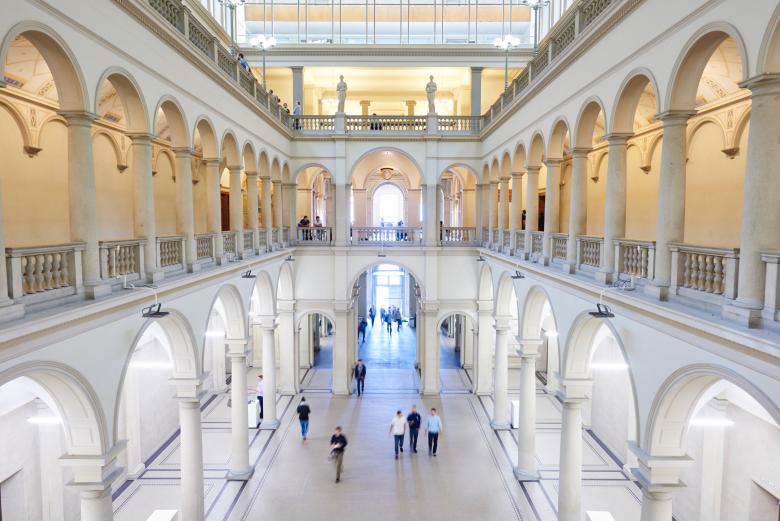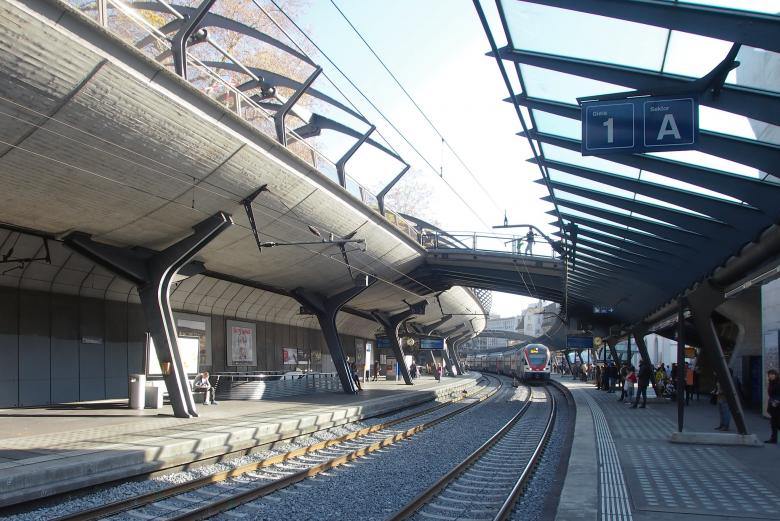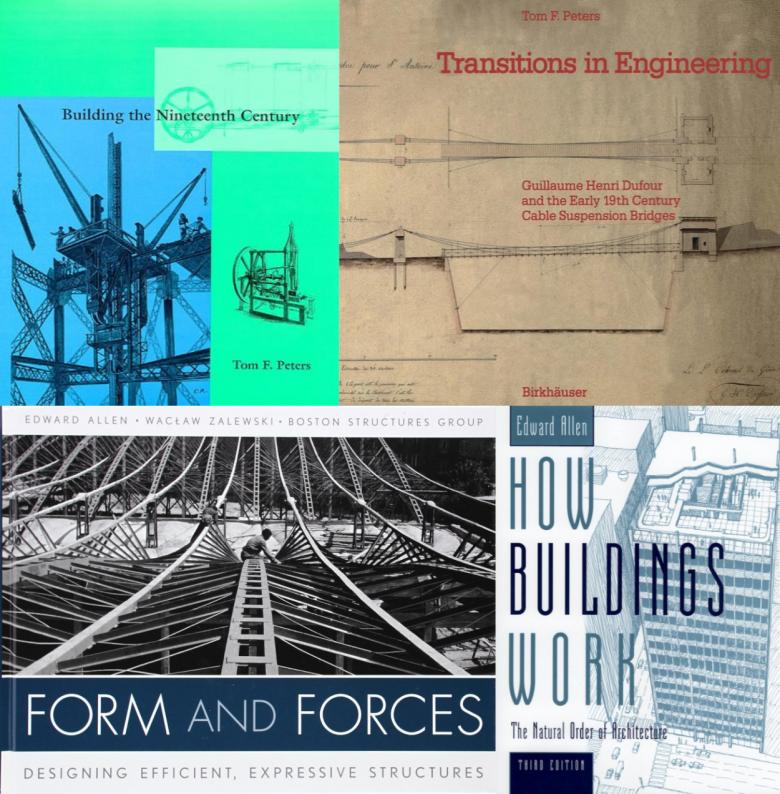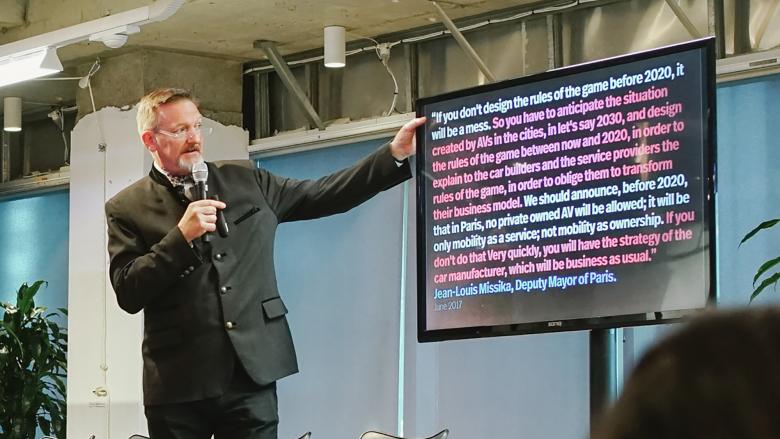Building Bridges with Chris Luebkeman
John Hill
26. April 2024
Chris Luebkeman
Christ Luebkeman is an engineer, educator, and futurist who leads the Strategic Foresight Hub in the Office of the President at ETH Zurich and is founder of Your2040, a yearly gathering aimed at accelerating change. World-Architects editor John Hill spoke with Luebkeman about these roles and the paths he took to get to them. Our conversation is edited for length.
John Hill (JH): You are leader of the Strategic Foresight Hub in the Office of the President at ETH Zurich. What does the department do, and what does your job entail?
Chris Luebkeman (CL): The Office of the President is the team which supports the president in executing his role as essentially the CEO of the institution. He is responsible for the overall leadership and strategic direction, he hires all the new professors, he's in charge of making sure that our relationships with society continues to grow strongly, and he's also responsible for ensuring the future viability of the institution, which means setting our institutional strategy. My team at the Strategic Foresight Hub is tasked with integrating futures thinking more broadly and deeply across the institution, and specifically in helping to draft our institutional priorities for the next twelve years. This task also incorporated a revision of our strategic planning process. We have two components: our institutional strategy which is top-down and our development plan which is bottom-up. So, we've been tasked with putting all this into a big mixer and making sense of it.
The ETH Zürich was created by an act of parliament at the end of the 19th century, and part of that act said we have to educate, research, and transfer what we're doing to society; these are our three mandates which we still work towards. We report to what we call a Federal Domain Board which consists of five national research institutions and two national universities. That board then has its strategic goals, which we need to integrate. We are a public institution, so it’s not like a private university in the United States, where you have your donors and you have to make sure you get the money. It's a very different situation here, since we have a contract quite literally with the Swiss citizen through parliament. Thus, when we look at our strategy we need to navigate the needs of the world with the needs of the nation. We're one of the top ten universities in the world, we address global challenges and fundamental science, as well as national or local challenges and in this way we serve Swiss citizens.
This is quite interesting from a design standpoint, as a design problem, using a lot of our design skills: How do you navigate between these different aspects to create this institutional strategy? How do you navigate these different groups? How do you gather opinions? How do you mediate between them — between the board, our parliamentarians, our citizens, our researchers, our faculty, then create a set of priorities which makes everybody happy? Some of them will be a little unhappy, but, you know, that's part of the game.
Poster from rETHinking Universities of the Future public exhibition at ETH Zurich’s Main Hall, February 20 – March 2, 2023.
JH: It sounds like you are dealing with curriculum, facilities, communications … as if you're dabbling in just about every aspect of the school.
CL: We spent about a year and a half asking, What's driving change in global higher education? The emphasis here is on global because the Swiss context is a subset of a global context; and the Swiss context is that Switzerland has one of the best education systems in the world for all its citizens: Any Swiss citizen can get a higher education, even if they do not finish high school; they can go to an institution of higher learning and the fees are minimal. This is in contrast to most schools in most nations, where only those who can afford to pay get an education. So, within this global context for higher education, what is driving change? Things like democracy being disputed: What are the potential impacts of democracy being disputed as a rational, liberal system? Or cybersecurity — we call it hydra-headed crime — where different criminal activities are seemingly a half step ahead of their civil counterpart? We asked ourselves: What are some of these factors that are important globally? And we assembled sixty of them — sixty factors — and we created these cards. Here’s migration [holds up card], a huge driver in global higher education. So we ask: What do we know? What do we not know? And what are some inspiring examples?
We used these cards and asked various communities within the ETH what they felt were the most important drivers for our future as an institution, what are the important ones for us? We had conversations with staff, students, researchers, employees, board members … we asked all of them about which factors are most important and why; what are the implications on our institution's capacity and capability? on the future of teaching? of learning? of governance? of research? We kept asking these questions and pulled the opinions together into what we call the strategic priorities. The process was very careful, I would even say scientific, in the sense of having these 60 factors with different lenses — classic drivers of social, technological, economical, environmental, political, and legal change.
JH: Although your job is institution-wide, with multiple universities, are there certain schools that you interact with more than others? Might architecture be one of those?
CL: For the strategic priorities we did not dictate any terms to one school. We had faculty from every school involved, so there were faculty from the Department of Architecture. And here at the ETH we asked all of our academic and support departments to share with us their strategy (some of them do shorter term strategies, others longer term strategies). Every eight years — two planning periods, as we plan in four-year cycles — the academic departments are up for review. Through the review process, each academic department has the opportunity to take a hard look at itself, asking what they have achieved, where they are going, how to improve, and what they need to do in order to achieve their goals. For some it can be the moment to start a process of renewal, for others a confirmation of direction.
Main hall at ETH Zurich (Photo © ETH Zurich / Gian Marco Castelberg)
JH: I'd like to take a step back and hear about your educational and professional background. I’m curious what brought you to this role you now have at the ETH.
CL: I grew up in Cincinnati, Ohio, in a classic middle-American household. My first education was as a carpenter, doing all sorts of little odd jobs and learning how to use my hands, but I became quite fascinated with concrete — I don't know why, frankly, I just did. Through my undergraduate education at Vanderbilt, where I studied civil engineering, I had the privilege of working in an engineering company in Cincinnati, where every summer I did an unofficial co-op. Each time I returned, the principal would sit me down and quiz me about what I learned; he would put me on tasks that were appropriate to my education, and by the end of each summer I couldn't wait to go back to school, because I'd use everything I'd been learning and could see there was so much more to learn. And that “so much more to learn” became my driver for the next twenty years. I got to see that, in engineering and design, there were many solutions to each problem.
I went to Vanderbilt for engineering but also did a degree in geology (my grandfather, a hero of mine, never finished university, so I finished his degree for him). With my love of concrete, I went to graduate school at Cornell and focused on the long-term behavior of concrete. There, I would walk across the quad from engineering to the architecture school to take various classes on the history of engineering. I was a bit of an odd turkey because everyone in the class was an architect, because it was an architecture class. I just got really curious and learned a lot from a professor named Tom Frank Peters; I learned about architectural history, the history of industrial processes, the history of tall buildings, the history of long span construction, and the history of concrete bridges. While I was there, in the Department of Architecture, I saw all these students who looked so haggard, sitting at drawing boards working on these projects. I'd start talking to a couple of them and gave them advice on their designs. And I discovered that I was good at it and more importantly, I really enjoyed it, and they appreciated it.
Salginatobel Bridge by Robert Maillart, 1930 (Photo: Хрюша/Wikimedia Commons)
Walking across campus was my first bridge — finding this bridge between these two academic/professional worlds — and falling in love with bridges was my second: the Salginatobel Bridge by Robert Maillart, an incredibly beautiful icon of form and structure. I decided I had to go to Switzerland to see it and learn how the Swiss were designing concrete bridges. So that's what I did: I got my degree at Cornell and came to Switzerland to work in the bridge professorship of Christian Menn, who taught me the difference between designing and calculating. I had been an incredibly good calculator and I thought I was a good designer — but I was not. When I talked to Menn, he talked about forces and structure as if they were living, moving entities; it was a way I just couldn't understand, it was not how I was taught. Then it slowly dawned on me that, while I was a great calculator, here was a true designer. I decided I wanted to become an engineering designer; I wanted to be able to manipulate the forces of nature, not just calculate them.
Then one day, Santiago Calatrava walked into the office and said he needed someone who could use a computer to do these load cases that the Swiss rail system was demanding for the design of the Stadelhofen Station, an inner-city station in Zurich for the suburban rail system. It was on a curve, and the SBB needed to know what happens if the train jumps off the curve — you can't figure that out with a slide rule. I knew how to do it, so I joined Calatrava’s office and proceeded over the next year to bring computational methods into his office, back when a computer running one analysis could take 6 to 12 hours.
Stadelhofen Station by Santiago Calatrava, 1990 (Photo: John Hill/World-Architects)
It was quite interesting with Santiago, to see how he found inspiration in nature and in art. Menn’s inspirations were the mountains, because he was from the mountains, but Calatrava’s were animal skeletons and natural joints. One day, when we were designing the Bach de Roda Bridge in Barcelona, he asked me to go through the works of Goya and gather sketches of bulls and horses — hundreds of them. Then Santiago, with yellow trace paper, draws the stances of the animals, the relationship between the people and the animals, going through this for hours. These sketches eventually turned into the arch and the supports of the bridge. It was fascinating to observe firsthand his design process in action. It embedded within me the importance in finding our own personal points of inspiration; Goya etchings don't really do it for me, but they did for Santiago, which is beautiful. Realizing that each of us has to find our thing was another important education for me, a big one.
I decided to go back to school, to the ETH, to study architecture and complete my education around the building — to understand not just the bones, but the skin, the kidneys, the heart, the eyes, the rest of the building. My professor at the time, Herbert Kramel, sat me down and said: “You can stay here for six years and get a diploma, or you can get a PhD.” Well, if you put it that way [laughs]! So I decided to do a PhD on the development of long-span concrete structures for large halls: “The Disappearance of the In-between” was the title. Every material imitates another material before it finds out what it really needs to be. The first concrete structures imitated wood and steel, until what I call the disappearance of the in-between, when the compression and tension which you have in a truss are minimized to a shell, which is really the appropriate form for concrete. It was important for me to learn how to speak with architects on a professional basis, so I taught structures to architects there, hundreds of architects. That was another part of my education: learning how to build that bridge.
Covers of books by Tom F. Peters (top row) and Edward Allen.
JH: So, between this education and the Strategic Foresight Hub at the ETH you worked at Arup for around twenty years. Can you speak about that experience?
CL: At the ETH I realized I loved teaching structures to architects, helping architects understand the potential of technology to inform design and not be a burden. Then I went to Oregon to teach at the University of Oregon — straight from cerebral Lake Zurich, where Le Corbusier still walked the halls and every architect only wore black, to “Blue Jean Eugene,” where you had to wear tie dye to fit in. It was a bit a culture shock, a beautiful culture shock, frankly, because the lessons I learned there were about environmental systems and respect for nature and learning from nature. And, every faculty taught both design and their specialty which was very different from the segregated sociey at the Department of Architecture at ETH. I loved my time at Oregon and had the opportunity to meet many colleagues who were also teaching technical subjects in schools of architecture. In my second year there, Edward Allen, who did all those construction books, Tom Peters, again, and I were asked to review the new architecture program at the Chinese University of Hong Kong. It was under the leadership of Tunny Lee from MIT and was growing rapidly. We made a series of recommendations regarding the technology program. I was the junior of the three and was the one “suggested” to implement the suggestions. So, I moved to Hong Kong to teach both Design Studio and Structures for one year.
Tunny suggested that I take a look at a position at MIT which was open. I did. I applied, and then I went to MIT to join William J. Mitchell. I was interested in computational tools at Oregon, where I created the very first teaching website for architecture: the Architectonic Studio. I had fallen in love with the web as a tool, and for that Bill Mitchell (City of Bits) was the guy. I was deeply fascinated by his understanding of the power of digital and with what he was thinking and doing, so I went and joined his team. At MIT, I took over a course called Integrated Building Systems, which was bringing design and technology together into an integrated studio. It became very popular because it gave students rational criteria with which to assess the success of their designs and not just a personal opinion of a professor. I sent one of my graduate students to Arup, which I got to know as a company while in Hong Kong, to study material selection. He went over to work with Steven Groak, the head of R&D at that time, and who suddenly passed away from brain hemorrhage. So, Arup needed a new head of R&D and they basically headhunted me from MIT to join. So, that’s what I did, becoming co-leader of the R&D group, which was about 50 people — the biggest brains on the planet enabling Arup to do all these amazing things. I was with Arup for twenty years. I was a corporate Intrapreneur multiple times. I founded the Foresight team, created our innovation and incubation programs, co-founded our corporate University, and so on. Essentially, I was interested in creating the various bits which would empower the future of the company.
JH: It sounds like that role was less project-specific, say like engineering, and was more aligned with what you're doing at the ETH now.
CL: It was, for sure. That was a very long excursion to get to it [laughs], but yeah.
Chris Luebkeman, as Arup’s Director for Foresight, Research and Innovation, presenting at the “Shaping our City” event in Sydney in March 2018.
JH: Might you have advice to architects who feel uncertain about the future, because of climate change, for example, or artificial intelligence?
CL: As I look back, there are a few threads which are quite similar. One was bridge-building: trying to bridge between cultures, bridge between professions. Within Arup, even, the role was about trying to help make sure our projects were fit for their purpose, fit for the future; as consultants, we had to think about thinking about the future. Even if they don't know it, architects are trained to do this from day one; they are trained to design into the future, whereas engineers are typically given something and are asked to make it work. In my mind, architects are perfectly trained to be futurists and to try to embrace the variety of forces which are driving change, be they technological, environmental, or social.
When I look at the future, for me, for architects, it's profoundly positive; and I would say for engineers as well. The digital tools which are coming, which are going to be required for us to deal with the challenges of climate change, of regeneration, of the circular economy … well, quite frankly, we are going to need every little bit of help we can get. I am convinced of this because, within the next 20 to 30 years, we are going to be called upon to fundamentally renovate about half of what we have built. That's a lot, and there's no way we could do this with the tools and materials we were using 10 or 20 years ago. We need these artificial intelligence tools, the digital twins, BIM, advanced BIM, whatever. We need these to help deliver what we will be required. At the same time, I believe very deeply in our humanity and the requirement to not lose touch with our humanity and our humility. At the end of the day, this is about us as living beings inside a global ecosystem. We are not above nature; we are part of nature. We've convinced ourselves that we're above this system, but we can no longer look at ourselves in this way. We're part of it and we require everything else to be healthy.
The next Your2040 gathering takes place in La Punt, Switzerland, from June 19 to June 22, 2024.
JH: Lastly, can you speak about the project you started, [Y]our2040? What is it and how does it address these issues?
CL: Absolutely. [Y]our2040 is my passion project which aims to be a world-renowned community of actionists shaping the future, sharing ideas, influencing global dialogues, building momentum, and implementing creative solutions to accelerate the transition to a regenerative future. It is a movement, community, and a gathering. Many people in the world know what we're afraid of, but what are we really aspiring to? What does a pragmatic, positive future for your hometown, your street, your neighborhood really look like? When the world is warmer by two degrees Celsius, when the droughts are continuous, as we're seeing in the United States or Spain or Ethiopia, when the aquifers are disappearing … at some point, all of a sudden, we will have to change our behavior. What we want to do with [Y]our2040 is create visions for positive pathways forward, given the changes which science is telling us are going to occur. At the end of the day, we have a duty as professionals to be thinking about these things.
So, we bring 100 people together in the summer for three days. For the first three years we focused on themes (mountain communities, water, regeneration) and we brainstormed about projects that could be amplified or needed to happen. Now we're starting a multi-year project entitled “a day in [y]our life,” where we take a look at the question: What does a day in the life of a person, a building, an animal, an insect or a natural system look like today? These are our characters, and what will it look like in the future?
We are working collaboratively with the local community of the central Engadine Valley of Switzerland to map and understand the lives of each of our 18 characters today. What do they do? How does the interaction between them weave together into a rich tapestry of the story of the place? We will then learn about the changes which science says will occur to reimagine what the ‘lives’ of our characters might look like in the year 2040. We will weave together positive visions for our future with our partners, creating high production value visions for [y]our collective future. We will also be envisioning the positive transition pathways to achieve these visions: How do we get there by 2040? 2050? What are the steps we need to take in order to get there? What already exists and what doesn't? What laws, policies, products, and services do we either need to amplify or to create to get there? We focus on making sure those things happen and then we rinse and repeat [laughs]. We are going to start here this summer, and then we'll expand to other cities in 2025 and beyond. Our goal is to be able to look into the eyes of the children of the next generations and to be able to say that we did everything we could to leave them the best world possible.







